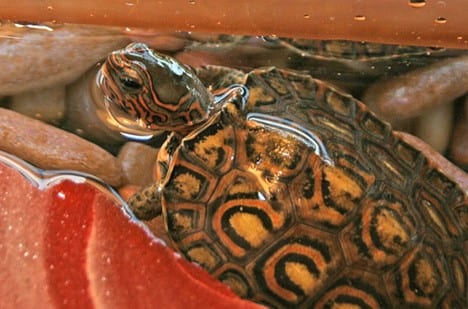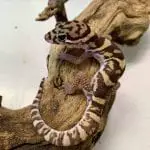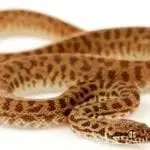Scientific Facts
| Common Name: | Central American Wood Turtle, Ornate Wood Turtle, Painted Wood Turtle |
| Scientific Name: | Rhinoclemmys Pulcherrima |
| Life Span: | More than 20 years |
| Length: | Around 8 inches |
| Clutch Size: | 3 to 5 eggs |
| Habitat: |
Physical Description

The Central American Wood Turtle is a species of turtle from Central America. Adult turtles reach about 8 inches in length. The males have longer tails and are generally smaller compared to female turtles. The patterns of the turtle shells vary individually. Turtles from Nicaragua are less showy compared with their counterparts from Costa Rica.
These turtles are known for their wide range of colors. Costa Rican turtles showcase bright colors, while Ornate wood turtles usually have a subdued hue. Some turtles standout with their orange and yellow swirls, along with different levels of black eyespots on their carapace. Some also have a bit of pink or red on their plastron.
Behavior
Central American Wood Turtles need to be provided with a variety of hiding places, including a pile of cork bark tubes and dried leaves. They have the tendency to be shy. This is obvious when you approach them, and your turtle will start running to a sheltered place, and come back out an alert if you start offering him with food.
Turtles that are captive-hatched usually make better pets compared with those that are imported and wild-caught. With proper handling and care, these turtles can become calm and docile that they can even be fed by hand.
Feeding and Diet
Central American Wood Turtles love digging for food. They have also been reported to listen for invertebrates that may be present beneath the soil. As these turtles are omnivores, they also eat fresh vegetables and fruits, such as collard greens, bananas, melons, as well as smaller mammals like mice. They also love invertebrates such as beetles, grubs, and earthworms. If you prepare a good setup that will allow your turtles to dig some of their food, it will make them healthier.
If you opt to keep your Central American Wood Turtles in an outdoor location, make sure to prepare a backup enclosure indoors. This will help in keeping your turtles even at night time, especially with the harsher conditions in winter becoming severe.
Habitat
The habitat of Central American Wood Turtles is located at 10 to 13 degrees N.L, within the dry tropical woods. They usually range between Mexico, Sonora, and Costa Rica. They are semi-aquatic animals, living along forested streams and rivers, and typically in cool and upland areas of marshy meadows, woodlands, farmland, and red maple swamp habitats. They are also found in wild habitats in Nicaragua.
Housing
Central American Wood Turtles are semi-terrestrial, which means that you need to prepare an enclosure that mimics the environment familiar to them, that of a marshy pond, but a bit drier. These turtles thrive in an outdoor area, provided that the enclosure is spacious enough, with an approximate size of 8 inches by 8 inches.
A wide and long enclosure that is covered with a screen lid is preferred compared to an aquarium tank, though if you want to keep your turtle inside a tank, the recommended size is at least 75 gallons. For each additional turtle, add 50 gallons to make them comfortable.
Wood turtles are semi-aquatic, which means that they love soaking in water for several hours on end. They will love having a “swimming hole” at one part of their enclosure by inserting a plastic or glass partition to create both land and water locations. A hole can also be drilled right into the bottom of the water area to serve as a drain when cleaning. As an alternative, you may want to prepare a wide tray that measures up to 6 inches in depth, serving as a water area. It should be lifted out easily for cleaning.
Substrate
When preparing for an indoor enclosure, select a substrate that consists of three layers. The first layer can be made of pea gravel, and the second layer about 10 to 12 inches deep and is made of half dampened sand and half peat moss.
You might also want to plant some tropical, or at least tropical-looking plants, such as pokeberry or broad-leaf cannas. This will give your turtles with enough place to escape from the heat and privacy that will help them to thrive and survive. They also love the darkness offered by tropical forests and would appreciate an environment that will mimic their natural habitat.
Water
There is also a need to provide your turtle with a paint tray or a pan that is filled with clean, fresh, and filtered water. Water needs to be regularly changed to ensure its overall cleanliness. Piles of leaves, hay, and sheets of bark can also be provided to give your purple some hiding places to make them safe and secure while on land.
Lighting and Temperature
A UVB light bulb can be positioned right overhead inside the enclosure, together with a 100-watt light bulb right above the basking area. A temperature that is recommended and comfortable for your turtle is anywhere between 76 to 86 degrees Fahrenheit. Even though slight fluctuations will be tolerated at night, the temperature needs to be kept over 60 degrees Fahrenheit.
The temperature for basking should be within the range of the high 80s and low 90s Fahrenheit, while the water temperature needs to be about 75 degrees Fahrenheit. The humidity level should also be set to around 60%.
How to Care for a Central American Wood Turtle
Central American Wood Turtles are omnivorous, which means that they usually love eating earthworms, redworms, and crickets. They also need to be provided with a lot of salad in order to boost their health. This salad should also be filled with shredded fruits and vegetables, including banana, mango, cantaloupe, apple, zucchini, squash, and kale. To provide your turtle with all the nutrition needed, you can dust their food with high-quality calcium and multi-vitamin supplement powder.
Captive-bred Central American Wood Turtles are rarely available, though it is still possible to find quality specimens. For this reason, these turtles have won the attention of dedicated hobbyists, thus improving their interest while forcing higher prices for the healthier ones.
It was quite common back then to see some heavily parasitized and severely dehydrated specimens, but now, with better information available on captive-care, Central American Wood Turtles can expect better care from their owners. While some turtles may still arrive filled with worms and harmful microbes, they can still be treated accordingly.
Central American Wood Turtles are among the easiest species to care for. The best way to offer captive care for these turtles is by preparing an outdoor enclosure, at least during summer months. Even though they are highly aquatic, especially the juveniles, they are not really pond turtles, which is why a large land area for roaming around suits them best.
A recommended enclosure, whether indoors or outdoors, is one that measures about 6 feet x 8 feet x 9 inches in height. Access to the freshwater ponds should also be present, covering around one-third of the size of the enclosure.
Breeding
Male turtles are generally smaller and usually less robust compared to their female counterparts, with a carapace length that averages around 7 inches. Females, on the other hand, average around 9 or 10 inches in length. The tails of the male turtles are longer than that of females, even extending past the rear of their carapace. They are also thicker because they have a male reproductive organ. Male turtles also have a concave plastron that is designed to help them in copulation.
Captive breeding of Central American Wood Turtles is possible, possibly because of being imported gravid or having a captive condition that encourages breeding. Captive-bred turtles usually show increased interest in reproduction with one another toward late summer, especially when the nighttime temperatures start to drop.
During these periods, receptive females are approached by males fearlessly. Reproduction may happen throughout the entire day, though most attempts are successful in the early hours of the morning before they feel the heat of the day. To signal attraction, males usually head-bob females. With the presence of other males, aggression may be observed, but rarely.
Female turtles may be nipped in the face and neck by males that are overly anxious during attempts to copulate, and this may last several minutes to a number of hours after. Actual injuries and bites happen rarely. Copulation may also take place in or out water, usually with males being dragged by the female turtles from land to water and vice versa.
After 30 to 50 days after success in copulation, the female turtles will start to nest in a way that common among semi-aquatic species of turtles. They need to excavate a nest that is about 5 to 7 inches in depth in a corner, or in a shrubbery within their enclosure.
Digging of their nest may take up to two hours, and if they are interrupted, they may flee the site and attempt digging again at a different location. Female turtles, just like other turtle species, often urinate in their nest in order to prevent it from falling and collapsing as they continue to dig.
The females may lay up to four clutches every year. Each clutch has a size of three to five eggs. These eggs are elongated in shape, roughly measuring 11/4 inches in width and over 2 inches in length. Hatchlings are usually just below 2 inches in length and are relatively darker compared to the adults.
Sexes can be determined by the temperature of the nest, with cooler temperatures usually producing male turtles, while warmer temperatures often produce females. When using an artificial incubation setup, the temperature needs to be set within 84 to 88 degrees Fahrenheit.
Hatchling Care
Hatchlings need to be cared for in a similar way as caring for adults. Even though they also need to be provided with the means to be dry completely, the hatchlings also need higher humidity, typically around 80%, as well as access to clean and shallow water. They need a higher amount of calcium and protein than the adults, along with full-spectrum lighting that is beneficial for appropriate vitamin production and calcium processing.
The diet of hatchlings needs to be 80 to 90% protein, with calcium supplements dusted on their food twice a week. Even though these hatchlings can be left outdoors, it is highly recommended to care for them indoors. In this way, they can be monitored easily for healthy growth and development, while eliminating a number of safety concerns, including predation. If possible, hatchlings need to be provided with enough exposure to the natural source of sunlight.
Where to Find Central American Wood Turtles
Most of the available Central American Wood Turtles are imported. The number of captive-bred turtles that are available now is greater than before. Still, you can find hatchlings that are captive-bred, including sub-adults and adults. They are available at reptile shows, pet stores, as well as through some reliable online dealers.
FAQ Section
What do Central American Wood Turtles eat?
Central American Wood Turtles are omnivores and will eat about any food available. They eat greens, fruits, and vegetables, as well as roaches, crickets, pinky mice, and nightcrawlers.
How big do Central American Wood Turtles get?
There is a variation in the length of these turtles, depending on their range and distribution, though the average length of adult turtles is about 8 inches.
Can Central American Wood Turtles swim?
Central American Wood Turtles usually spend their time in the water, as they are semi-aquatic. They love swimming as much as they also love spending time basking on the land.
Are Central American Wood Turtles endangered?
These turtles have been listed on the IUCN red list as vulnerable species since 1996. They are also listed as species of special concern in the state of Connecticut.
Are Central American Wood Turtles aggressive?
The males are observed to be aggressive, with older and larger turtles being more dominant than the others.


